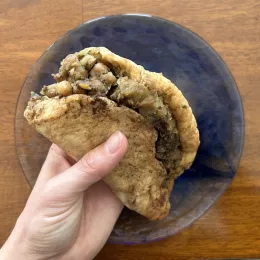The Institute of Culinary Education has teamed up with GrowNYC for a monthly series highlighting a seasonal ingredient at the farmers’ market.
Concord grapes can be hard to find fresh, as they have a short season starting in September and ending in early October. Look for them at the farmers' market or in specialty food stores, and you’ll be rewarded with a rich, round grape flavor with a lot of tartness that might already be familiar to you.
Pastry & Baking Arts Chef-Instructor Kierin Baldwin chose to feature Concord grapes because their flavor is reminiscent of her childhood and likely, many of our own childhoods as well. Concord grapes are used to make grape juice and jelly and the iconic taste is what grape flavoring is styled after.
Chef Kierin cooks down the grapes into a thick syrup which is swirled into no-churn ice cream, and to add to the nostalgia, topped with brown butter peanut shell.
Peanut butter and grape jelly is “a formative flavor memory for me from when I was young and it’s still deeply comforting,” she says.
Chef Kierin explains that Concord grapes are also hard to find because they are fragile. They are known as a slip-skin grape, meaning the pale green flesh easily separates from the skin, making them difficult to transport. Many chefs cannot find the fruit fresh for most of the year.
While they aren’t considered a good "table grape" due to their fragility and their seeds, Concords are popular in professional pastry kitchens because of their distinct taste. Concord grapes are often turned into deeply flavorful sorbets, jams and pie fillings.
Related Recipe:Chef Penny's Concord Grape Tart
In her recipe, Chef Kierin cooks the grapes with sugar and lemon juice to make a jam. For her, jams with both sweet and tart notes are always the most interesting, flavor-wise.
“Acidity is what makes your mouth water," she says. "The acid from the lemon also helps set the natural pectin in the grapes that help thicken the jam.”
Chef Kierin cooks the jam with the fruit’s seeds intact (versus removing them beforehand) because the seeds infuse even more deep, rounded grape flavor to the finished jelly, with a less noticeably tart taste.
The jam is folded into her no-churn ice cream base, which doesn’t require a machine.
In the normal process of making ice cream with a machine, churning is key. Churning gives ice cream a creamy, smooth texture by incorporating air into the mixture while breaking down large ice crystals. Churning also slightly whips the milk fat in the recipe, helping the ice cream stick together.
Related: Salt & Straw’s Keys to Making Great Ice Cream
Chef Kierin’s recipe works because the base ingredients and techniques mimic what would happen in an ice cream machine:
- Whipping the heavy cream adds air and gives the coagulated milk fat a silky creaminess.
- The condensed milk adds concentrated milk solids — which are often added to ice cream in the form of non-fat milk powder, which helps stabilize and impart a creamy, rich mouthfeel.
- Commercial cream cheese often includes gels and stabilizers as ingredients, which help to prevent iciness. Cream cheese also works to balance the sweetness of condensed milk with a slight sourness.
To top it all off, Chef Kierin creates a brown butter peanut topping which makes the whole dessert feel a little more "grown up."
The browned butter has a rich, nutty flavor that adds complexity and deepens the peanut butter. Chef Kierin recommends using commercial peanut butter with added sugar and suggests serving the shell on top of the ice cream or swirled into the base, along with the grape jam, to create a peanut butter ripple.
As the seasons change, feel free to mix and match the base with other seasonal fruits. Chef Kierin adds that almost any fruit will work well, especially berries, peaches, nectarines, mangoes and even apples. You may need to tinker with the amount of sugar and lemon juice (or other types of acid) and cook the jam a little longer if your chosen fruit has lower levels of pectin than Concords.
More from this series:

Ingredients
For the Concord Grape Jam:
- 375 grams Concord grapes, washed and stems removed
- 130 grams granulated sugar
- 40 grams (a bit less than 3 tablespoons) fresh lemon juice
For the No-Churn Ice Cream Base:
- 45 grams cream cheese
- 2 1/2 cups heavy cream
- 1/4 teaspoon fine sea salt
- 1 14-oz can sweetened condensed milk
For the Brown Butter Peanut Shell:
- 70 grams butter
- 130 grams creamy (or 180 grams crunchy peanut butter)*
Directions
For the Concord Grape Jam:
- Put the Concord grapes in a small pot and add the sugar. Mash the grapes and sugar together, crushing them just enough that the skins separate from the green inner flesh of the grapes. (You can use a fork or potato masher or even just your hands for this. And don’t worry if the seeds don’t loosen from the flesh — that will happen as the jam cooks.)
- Bring the pot up to a boil and then lower the heat to a steady simmer and continue to cook, stirring occasionally, until the flesh of the grapes has turned purple and softened enough to release the seeds. The mixture should be starting to thicken and become syrupy.
- Add the lemon juice and continue to cook, stirring frequently to prevent scorching, until the mixture has thickened enough that a small amount deposited on a cold plate sets up into a loose gel.
- Turn off the heat and pass the mixture through a food mill or strainer to remove the seeds and skins. Press plastic directly on the surface of the jam to prevent a skin from forming and then place it in the fridge to cool while you make the ice cream. This can be made a day in advance of making the ice cream mixture and then stirred to loosen it a bit before using.
For the No-Churn Ice Cream Base:
- Combine the cream cheese, heavy cream and salt in a bowl and blend with an immersion blender until the cream cheese has completely combined with the cream.
- Whisk the mixture until it thickens to medium peaks.
- Add the condensed milk and fold it together with the cream mixture until just combined.
- Pour a quarter of the ice cream mixture into a 1.5- or 2-quart casserole dish or bowl. Stir the cooled Concord grape jam just enough to loosen it up and dollop about a third of it onto the ice cream mixture. (Or you can put the jam into a piping bag and pipe a third of it onto the cream mixture.)
- Add another quarter of the ice cream mixture to cover the jam and then dollop again with Concord jam.
- Repeat once more with another quarter of the ice cream and the last third of the jam before covering everything with the last of the ice cream mix.
- Quickly fold the jam into the ice cream mix a few times, so that some of the jam and ice cream combine slightly to form ripples throughout but still leave large pockets of jam.
- Place the dish in the freezer until the ice cream has a firm, scoop-able consistency for at least 4 hours.
For the Brown Butter Peanut Butter Shell:
- In a small pot, melt the butter and then continue to cook, swirling the pot occasionally, until the milk solids drop to the bottom of the pot and begin to turn brown. The butter is just the right color when it’s a medium brown, like a milk chocolate.
- Immediately pour it over the peanut butter in a heat proof bowl, scraping all of the delicious browned butter bits out as well, and whisk them together. That’s it! You can use it right away or refrigerate it and then microwave it until it’s liquid when you want to use it. It will keep in the fridge for two weeks.
*Ingredient note: This is one recipe in which I would recommend using peanut butter with added sugar, meaning not natural peanut butter. Skippy or JIF work well here.
More Unique Ice Cream: Pressure-Cooked Onion Ice Cream






